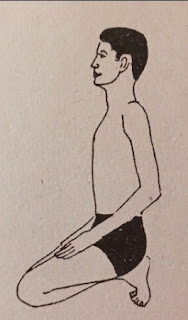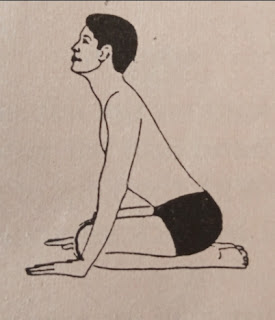VAJRASANA
(The Thunderbolt Pose)
How to do vajrasan
In this Asana, the posttion of the legs is firm like the Vajra - the adamantine weapon of mentioned in mythology - and therefore this Asana is called Vajrasana.This name is popularly supposed to have another origin. How to do vajrasana Vajra in Sanskrit means genitals. It is said that the name Vajrasana is given to this Asana as its practice benefits the lower abdominal area.
Caution : Those having a stiff ankle or stiff knee joints should practise this Asana very slowly. There should be no haste in attaining the posture.
Leading and Preparatory Practices : It is advisable to practise for a few days Shwanasana or the preliminary posture of folding alternately one leg at a time and keeping it under the same buttock as shown in fig. 8.
SHWANASANA (The Dog Pose)
Starting Position : Sit upright resting your knees and toes on the floor. Rest the palms near the groins. Join the knees, toes and heels (fig. 1).
Technique of Attaining the Asana : Bring the palms on to the knees and let the body weight come on to them. Now slide the palms to a point about six inches to the front of the knees. Raise the haunches.How to do vajrasan Turn the toes the other way (fig. 2).
Fig. 1
Now open out the joined heels but keep the big toes in contact. With your feet thus forming a comfortable seat, gently lower the buttocks on to this seat (fig. 3). Bring palms back towards the knees so that the wrists come in line with the knees.How to do vajrasana Keep the four fingers together and the thumb a little apart. Now on the support of the hands and the folded legs straighten the torso and nudge it forward. Project and raise the head slightly. At the same time pull back the shoulders so that the back is curved into a concave position. While performing these operation keep the buttocks steady on the feet. This is the final position of Shwanasana (fig. 4).
(Note: If you find it difficult to perform Shwanasana with the knees together, you may keep them apart.)
Fig. 3
Fig. 4
Breathing : Normal and natural throughout.
Eyes and Attention : Close your eyes, go in for differential relaxation and do Pranadharana.
Releasing of the Asana : Open your eyes, shift the palms about six inches to the front, raising the buttocks. Turn the toes to the front and rest the feet on the ground. Now take the buttocks to the back and sit resting on the toes. Keep the hands on the thighs and come to the starting position (fig.1).
Practice : In the begining, practise 2 to 3 rounds of 5 to 10 breaths each. After good practice, perform only one round of 1 to 3 minutes.
VAJRASANA (The Thunderbolt Pose)
Starting Position : For performing Vajrasana proper, sit on the floor in a comfortable position with the legs stretched out, keeping the hands by the side of the body (fig. 5). Technique of Attaining the Asana: Keep the legs together and the palms near the buttocks (fig. 6).
Fig. 5
Fig. 6
Now lean on the left side and balance the body weight on the left hand and left side. Fold the right leg at the knee (fig. 7). With the help of the right hand, place the foot below the right buttock smartly. The sole should face outward (fig. 8).
(Perform this posture as a leading and preparatory practice for a few days. As a preparatory practice maintain this posturefor a while. Come out of this Asana by leaning on the left side and supporting the body weight on the left hand. With the help of the right hand unfold the right leg and straighten it up through the stages shown in fig. 7 and fig. 6, to assume the starting position as shown in fig. 5. In a similar manner, perform this posture folding the left leg and placing it below the left buttock. Release the posture as described before, to assume the starting position as in fig. 5.)
Fig. 7
Fig. 8
After good practice of the above preliminary posture, you can go ahead for Vajrasana proper. For complete Vajrasana, having fixed the right foot under the right buttock as shown in fig. 8, lean to the right. Support the body weight on the right hand and on the right side. Hold the left sole in the left hand (unseen part of fig. 9). Place it below the left buttock in such a manner that both the big toes are near each other and the sole faces outward (fig. 10). Adjust the position of the buttocks on the upward-facing soles to obtain a firm and comfortable seat. Take the pelvis and lower abdomen slightly forward. Keep the spine erect in its natural position and the palms on the thighs near the knee joints
Fig. 9
Fig. 10
Fig. 11
(fig. 11). This is the final position of Vajrasana.
NOTES :
1. While sitting in the final stage of Vajrasana, if you experience discomfort or pain at the ankle joint, then for a few days you should practise it with a rolled towel under the ankle joints.
2. In the beginning it is better to place palms on the groins (instead of the knee joints) and bring elbows closer to each other (fig. 12). This will help you in keeping the spinal column erect in its natural position. After good practice, you will be able to keep palms on the knee joints without leaning forward or backward.
Fig. 12
Breathing : When you sit in such a restful pose, your breathing automatically becomes slow, steady
and deep. Eyes and Attention : Drop the eyelids shut. Relax the muscles of the abdomen and hands. Thus, practise differential relaxation consciously. Now feel the soft touch of the incoming and outgoing breaths at the palate or at the nasal septum. Lead the mind to the breathing and fix it there. Concentration, if it comes automatically, is fine.
However, oneshould not forcibly try to concentrate. If one does so, there is more harm than good. If the mind wanders here and there, let it do so. When the wanderings slow down, bring it back to the breathing. This is the final stage of Vajrasana with Pranadharana. After a thorough practice of Vajrasana (with Pranadharana), one can substitute Pranadharana by Sakshibhavana (explained in Chapter 2). The practice of Vajrasana (with Sakshibhavana) will help in purifying the mind..
Releasing the Asana : Open the eyes. Remove the palms from the thighs and place them on the floor near the buttocks. Leaning to the left, support the body weight on the left hand. With the help of the right hand unfold the right leg and straighten it out. Next, leaning on the right side, straighten out the left leg with the help of the left hand and assume the starting position.
Practice : In the beginning, practise 2 to 3 rounds of 10 to 20 breaths each. After plenty of practice, perform only one round of 3 to 10 minutes.
NOTE: Proper body and mind conditions for Yogabhyas are quickly attained by pratising Vajrasana with Pranadharana. Hence, start Yogabhyas with this Asana.
Probable Mistakes
- Forward or backward leaning of the torso.
Benefits :
Correction
- To avoid this, adjust the seat in such a way that the body weight is experienced down the spinal column on the buttocks.
1. Vajrasana improves the blood circulation in the lower abdominal region and maintains the health of the genital area. 2. It helps remove spinal defects and develops the habit of keeping the spinal column in its natural state.
3. As the ankle joints and knee joints are stretched in Vajrasana, it makes the muscles there flexible and improves blood circulation. The working of the nerves in these regions is also improved.
4. This Asana is very useful as a preventive measure for some types of rheumatic problems. how to do vajrasana.




















0 Comments